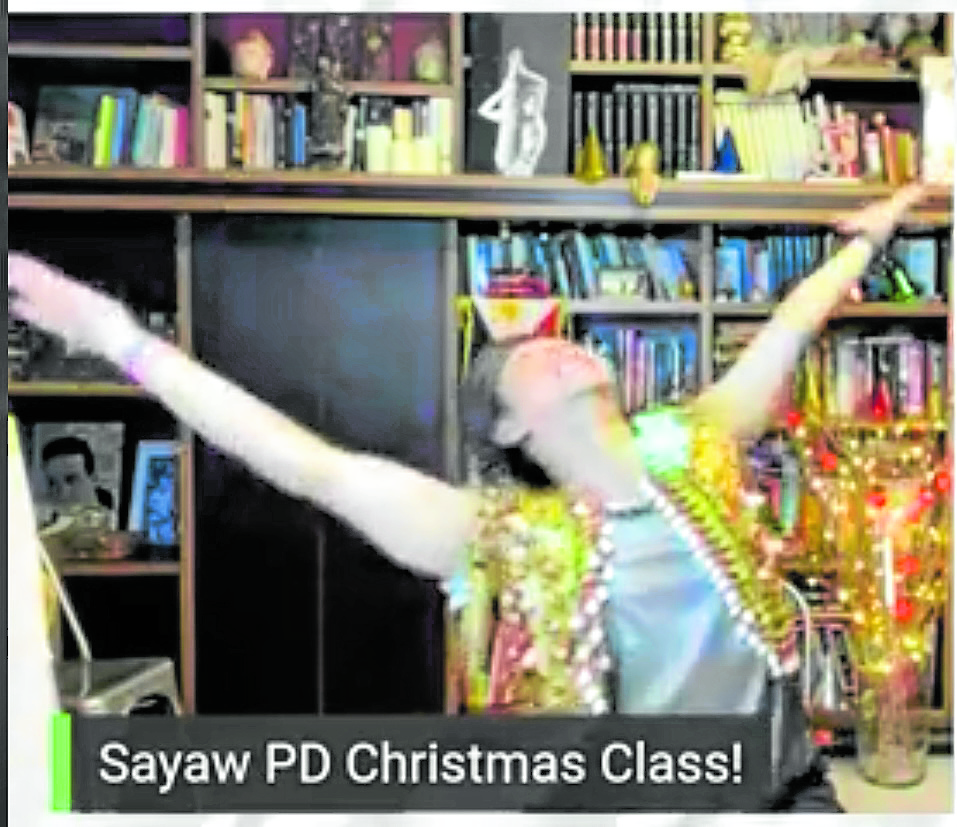In a room filled with books, punctuated by a Philippine flag, choreographer Novy Bereber dons a gold vest and greets participants on his screen. From his home in Sydney, Australia, he reaches out to a largely Filipino audience.
“This should be on performance level. We dance to be one and celebrate the spirit of Christmas,” he says.
Sitting on a chair, Bereber raises his arms and flicks his fingers as he speaks: “Imagine the snowflakes falling. Now stretch and grab the snowflakes.” Bereber sweeps his arms across the screen and pretends to seize large ice crystals.
He outlines a triangle and tells his audience to imagine a Christmas tree.
Then, lifting his chest toward the ceiling and stretching his arms to the side, he exclaims with wide grin, “You’re receiving a gift. Feel the joy!”
A mime class, it is not. The choreographer is addressing patients with Parkinson’s disease, a degenerative nervous system ailment that affects movement, balance and, consequently, emotions. In every class, the teacher aims to stimulate the students’ happy hormones through dance.
Launched in April, his Facebook page, Bereber Sayaw PD, Dance for Parkinson’s Disease, has posted over 100 classes. Facebook recently ranked his platform as No. 3 among the world’s most active and engaged dance programs for Parkinson’s disease. Students immediately feel comfortable with his high energy and chirpy voice.

Flowing movements
Eight years ago, Bereber, then a lead dancer for “The King and I” musical, felt that he had fulfilled his bucket list of performing at the iconic Sydney Opera House. One day, he came across a notice on the theater bulletin board about a dance teacher training workshop for persons with Parkinson’s. The requirement: 10 years of teaching experience in dance, fitness or physical therapy.
Dance educator Erica Rose Jeffrey, founder of Dance for Parkinson’s Australia (DPA), conducted the class in Sydney. On his first day, Bereber was awed seeing people with tremors, rigid muscles, impaired walk and lack of balance.
“We often complain about petty things. These patients couldn’t hold a glass of water,” he recalls.
He has since studied advance teacher training with David Leventhal, program director for Dance for PD, a collaborative program of the Mark Morris Dance Group and Brooklyn Parkinson Group in New York. Leventhal’s classes serve as templates for over 300 communities in 25 countries. Its basic precept is to cast off the label “persons with Parkinson’s” and call them “dancers.”
Studies have shown that flowing movements and proper posture help the patients to control their body and address Parkinson’s symptoms in the nerves and muscles. Stretching and strengthening improve their flexibility and balance. Regular attendees enhance their capacity to perform daily tasks. Listening to the music and using their imagination develop their creative expression and build their self-esteem.
Before the pandemic, Bereber, a senior teacher of DPA, taught at a community in Pennant Hills, a suburb in New South Wales. Whenever he came home to the Philippines, Harvey Chua, a supporter of People with Parkinson’s Disease Philippines (PWPDPH) community, would organize classes.
“I want to create awareness on Parkinson’s disease. When patients get depressed about their condition, they deteriorate. The classes aim to lift up their spirits. They should think that their session is a dance class. If it is called therapy, they would be reminded of their disease,” Bereber explains.
Capture the imagination
Early this year, he and his Australian husband, Ignatius Jones, were poised to resettle in Iloilo, Bereber’s province. The trip was delayed when Jones was hospitalized after a bad fall. By April, Australia went on lockdown. To assuage his anxieties about Jones’ condition and COVID-19, he put up the Bereber Sayaw PD page.
The classes are held every Monday, Wednesday and Friday, from 2 to 3 p.m. Philippine time. Although anyone can view the classes on Facebook and YouTube, Bereber prefers to see the patients via Zoom.
“Bereber Sayaw PD was set up as family-oriented, virtual community. Family and friends can join the class. Patients shouldn’t feel isolated from society,” he says.
As in any dance class, Bereber reminds the attendants of proper posture on their chairs and gives breathing exercises for relaxation. He warms up with head, neck and shoulder rolls and finger movements. The movements build up to arm gestures, chest expansion and engagement of the legs and feet, complemented with visual imagery.
Bereber finds it more challenging to teach Filipinos. Foremost is the ignorance on Parkinson’s disease. He observes that, in the provinces, patients with motor symptoms are tied and brought to the albularyo (folk medicine healer) or a priest for exorcism.
On the other hand, patients would rather take medication than commit to lifestyle changes such as incorporating a dance or fitness routine.
Yet, Bereber’s efforts have paid off. Sun Pharma Philippines, a multinational specialty pharmaceutical, made a donation for his virtual classes. Overseas Filipinos have likewise been connecting with him.
Bereber is popular for his animated style and humor.
“You have to be enthusiastic about teaching so that the patients can feel it. Otherwise, they will be as unresponsive as zombies. Once you’ve captured their imagination, they will follow you. Dance is one of the ways to bring joy into people’s lives,” he says. —CONTRIBUTED













































